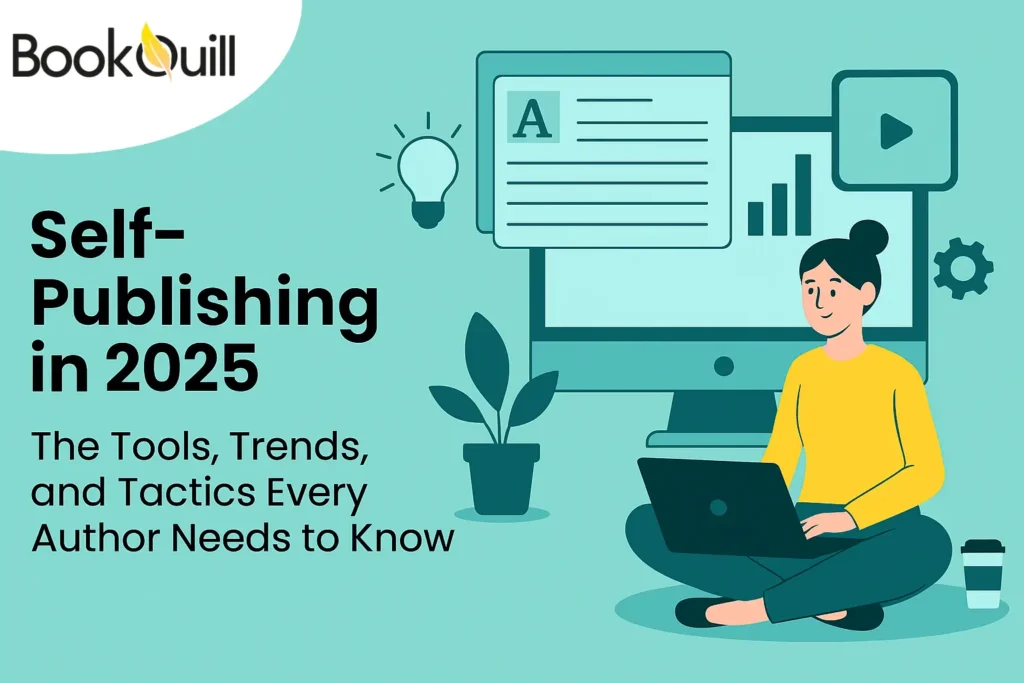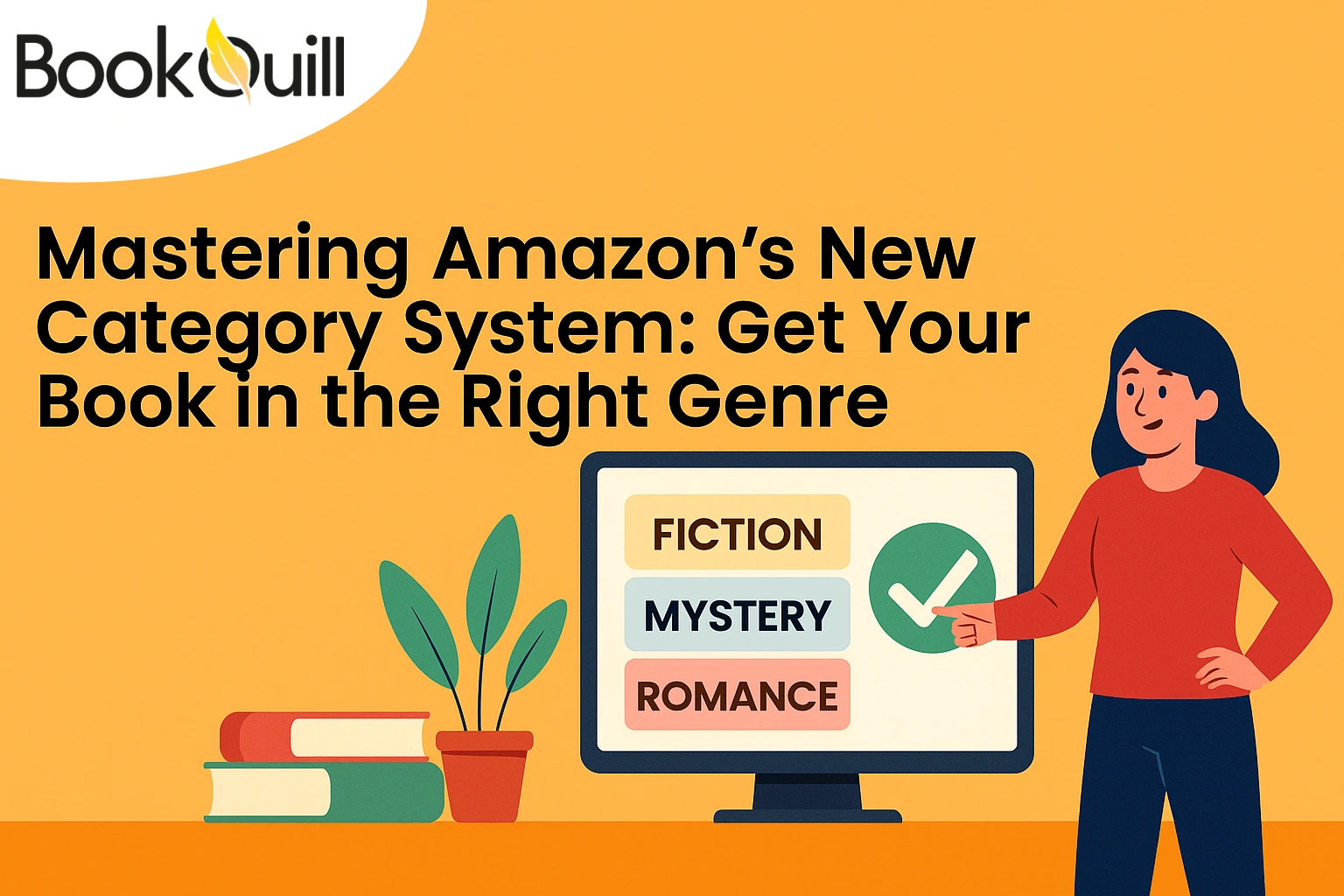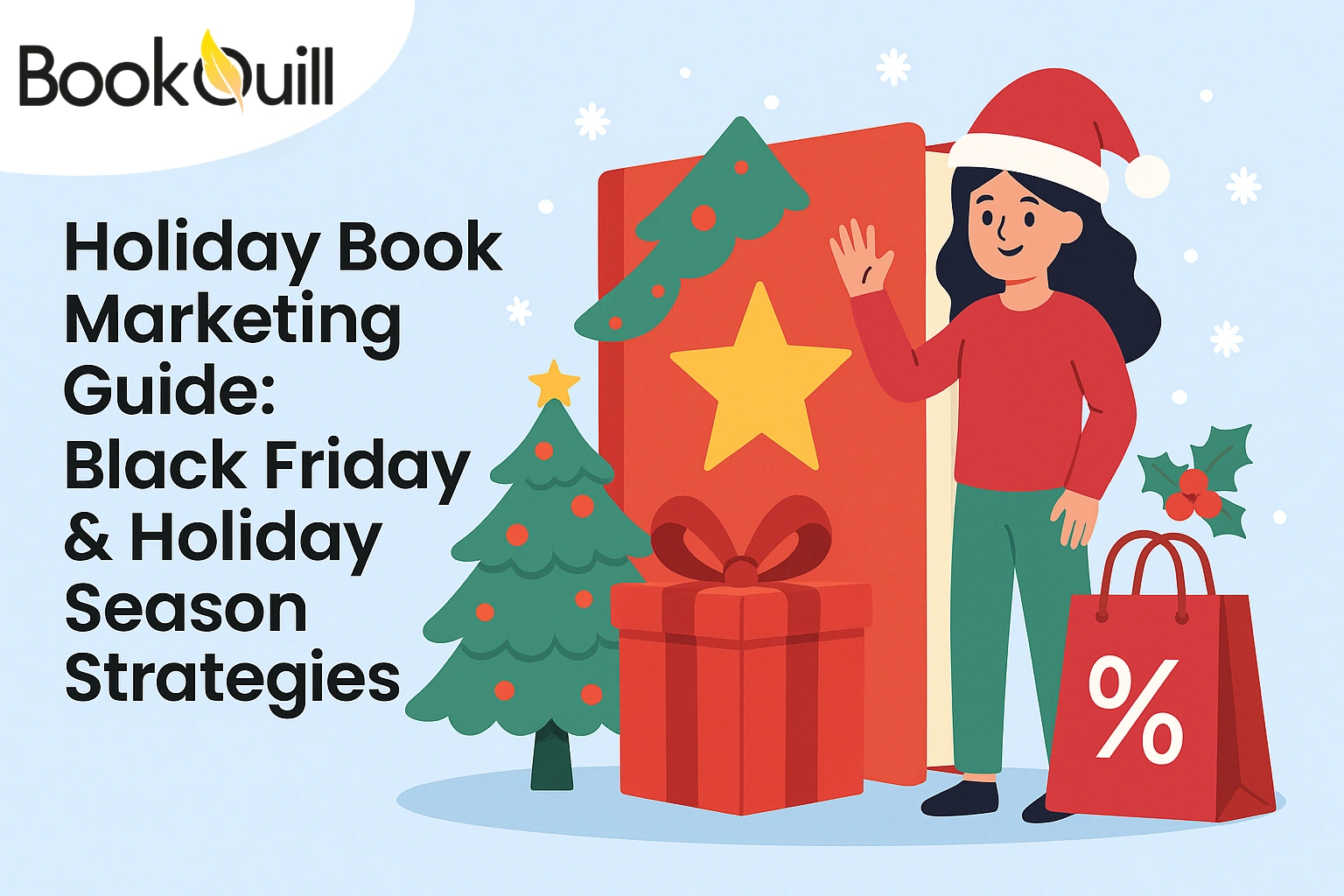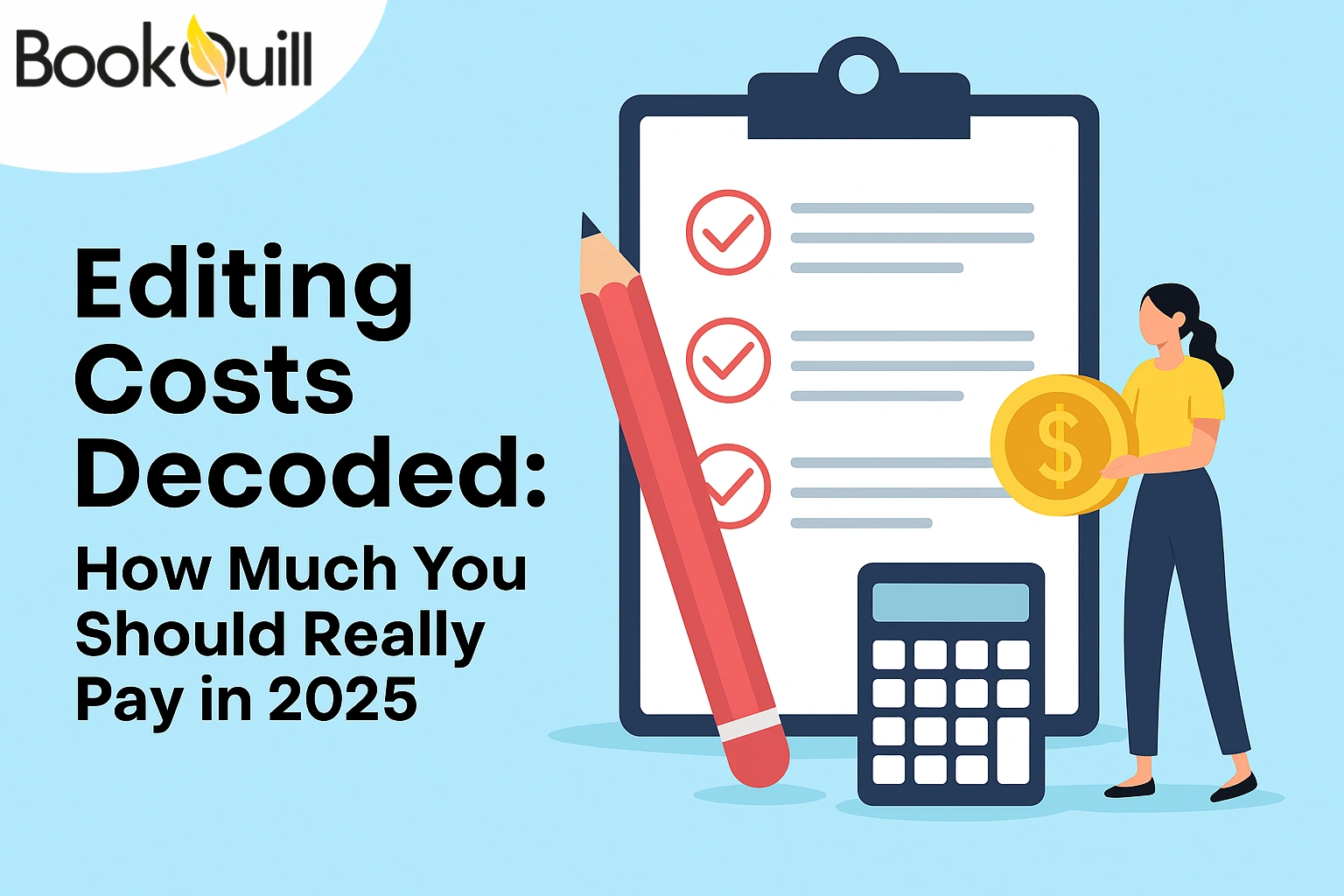Table of Contents
Explore Blogs
Trending on Ebook
Self-Publishing in 2025: The Tools, Trends, and Tactics Every Author Needs to Know

Well, you can say that in 2025, publishing your book will be quite easier than ordering a pizza, but selling it? That’s the part where most authors stumble.
Today’s self-publishing scene feels like a modern Wild West. The dusty pub doors open, and instead of cowboys with revolvers, you see authors with Scrivener licenses, Canva accounts, and way too many bookmarked articles about “How to hack Amazon’s algorithm.” Everyone is looking for gold; some are striking it big, while others are still digging holes in the desert.
What worked in 2015 just doesn’t cut it anymore. In fact, today, readers are quite clever, algorithms are trickier, and the competition is increasing. This means that if you want to thrive, you need publishing tools, an eye for industry trends, and the tactics to market yourself.
However, the good news is that never before has self-publishing been this powerful. You’ve got global reach at your fingertips, as well as AI tools and platforms that let you build an audience. But wait, don’t get too happy all of sudden, because it also means the bar is higher. And if you are not adapting or innovating, you risk becoming just another forgotten Kindle file.
In this self-publishing guide, we’re going to cut through the noise. We’ll walk through the tools that actually matter, the trends, and the tactics that can help you to increase your book sales. So, if you are debating with the trends, analyzing what can work best, and trying to figure out if investing in professionals is worth it, this guide is for you.
Key Takeaways
- Self-publishing in 2025 is a business and not a hobby. Authors need the right mix of creativity, tools, and marketing to thrive.
- Free book publishing platforms make it easy to get started, but investing in editing, design, and strategy is what makes a book sell.
- Staying on top of trends like audiobooks, AI, and global distribution is essential for any author following a serious self-publishing guide.
- Tools alone aren’t enough, but pairing tools with expert support from editors, designers, or marketers leads to long-term success.
- The choice depends on your goals, whether it’s choosing between a premium or an affordable professional book writing service. However, both can give authors a competitive edge in the market.
What Self-Publishing Really Means in 2025
Once upon a time, “self-publishing” was a bit of a dirty phrase. It brought to mind authors paying sketchy printers thousands, only to end up with boxes of unsold books in their garage. And if you tell someone you were “self-published” back then, you’d get the same look people give when you say, “I sell knives out of my trunk.”
However, if we talk about 2025? The game has completely changed. Self-publishing isn’t a backup plan anymore, but it’s the first choice for ambitious authors who think like entrepreneurs. Why? Because it lets you run your writing like your own business.
Modern Self-Publishing Is No Longer the Same
Let’s clear one thing first! Modern self-publishing is not vanity press. Vanity presses prey on hopeful writers, charge outrageous fees for subpar services, and vanish faster than your royalties. However, the real self-publishing is about professional author-entrepreneurship. That means you:
- Hire skilled editors or use AI-assisted ones smartly.
- Work with designers who understand cover psychology.
- Use self-publishing tools to format, distribute, and market your work like a pro.
- Take charge of your own success instead of waiting for a gatekeeper’s approval.
Freedom Comes with Responsibility
Self-publishing is freedom on steroids. You set the deadlines, pick the platforms, choose the cover, and decide the pricing. You can release your book worldwide tomorrow if you want.
But wait, freedom isn’t free. Along with independence comes responsibility. You’re no longer just a writer. You’re also the project manager, marketer, and accountant. You’re the one refreshing the sales dashboard at midnight and searching “how to run Facebook ads” when you should be asleep.
However, the advantage is clear, as control and higher profit margins remain in your hands. The risk, however, is just as real; neglect marketing, editing, or design, and your book can disappear into obscurity almost overnight.
Self-Publishing Guide: A True Career Path in 2025
According to industry data, self-published authors are capturing larger and larger chunks of the global book market each year. Audiobooks, eBooks, and serialized fiction platforms have all opened doors for indie authors who once would’ve been ignored by traditional publishers. In fact, some indie authors are now earning six or seven figures annually. And that’s not an exaggeration, that’s actual reality.
And while not everyone is going to make Stephen King money, what you can build is a sustainable and scalable writing career. Pair the right publishing tools with smart tactics, and suddenly you’re not just “self-published,” but you are a business owner with readers around the world.
This is why free book publication is tempting to many first-timers. Yes, you can get your book out there for zero upfront costs. But in 2025, the question isn’t just, “Can I publish my book for free?” It’s “How do I publish in a way that’s professional, sustainable, and actually profitable?” And that’s where knowing the right tools, trends, and tactics makes all the difference.
1. The Tools Every Indie Author Needs
You don’t need every shiny new tool to self-publish in 2025. In fact, chasing too many apps is the fastest way to burn out and end up with twenty-seven free trials charging your credit card at once.
What you do need are the essentials. These are the tools that save you time, make your book look professional, and help you reach actual readers.
Let’s discuss it in categories.
Writing & Editing Tools
- Scrivener & Atticus: Writers still turn to Scrivener and Atticus for drafting. Scrivener offers tons of tools, though it can be overwhelming. While Atticus is the newer, user-friendly cousin. Both are simpler and more approachable.
- AI-Powered Editing (Grammarly, ProWritingAid, Sudowrite): Think of these as the world’s fastest typo-hunters. Just remember, AI can catch passive voice, but it can’t tell you when your dialogue sounds like two robots ordering lattes. That’s why pairing AI with professional book writing services (a human editor with an actual sense of tone) is one of the best decisions you can make.
Formatting & Design
- Vellum & Atticus: Beautiful and clean formatting without the migraine. Drag, drop, and you have a professional-looking eBook and print edition.
- Canva & Photoshop: Canva works well for DIY covers if you’re on a budget, but be cautious, as many Canva covers end up looking exactly like Canva covers. For something truly eye-catching, think about hiring a premium book service or using platforms like 99designs to work with professional designers
- AI Art Tools: DALL·E, MidJourney, and similar apps can help brainstorm concepts, but their art can feel a little off. When it comes to book covers, humans still do it best
2. Distribution Platforms: Where You Reach Your Readers
- Amazon KDP: The elephant in the room. Still the biggest platform for indie authors, though no longer the only one that matters.
- IngramSpark & Draft2Digital: These let you reach bookstores, libraries, and international markets. IngramSpark has the widest reach, while Draft2Digital makes distribution easy.
- Niche Platforms (Radish, Wattpad, Smashwords): Great for serialized fiction, short reads, or testing new audiences. Perfect if you write romance, fantasy, or sci-fi with binge-worthy hooks.
In 2025, it’s not just about Amazon anymore. Readers are everywhere, on their phones, on subscription services, even listening to books while jogging. The wider your net, the more fish you catch.
3. Marketing & Promotion: Getting Your Book Seen
- BookBub Ads & Promotions: Still king of the mountain for visibility. Their featured deals can move thousands of copies, but competition is high.
- Amazon Ads: Yes, they work, but only if you avoid random guessing. Learn your keywords, test campaigns, and keep track of your budget.
- Social media & TikTok: Like it or not, TikTok sells books. Why? Because it feels real. Readers can spot desperation instantly
- Email Marketing (MailerLite, ConvertKit): Your newsletter is your golden ticket. Platforms come and go, but owning your reader list means you’re not at the mercy of algorithms.
Remember, tools are only useful if there’s a strategy behind them. Running ads without a plan is like yelling ‘Buy my book!’ with a sign around your neck. It’s marketing, sure, but not effective.
The Trends Defining 2025 (a.k.a. The Cool Kids Table)
Trends are the architecture of self-publishing. They shape what you build and how it stands in the world. And right now, publishing trends are moving faster than you can even imagine. Blink, and you might miss the next big shift.
So, what’s hot in 2025?
1. Audiobooks & AI Narration
According to industry reports, audiobooks have been the fastest-growing publishing format for more than five consecutive years. In 2025, global audiobook revenue is projected to reach US$9.84bn, leading to a projected market volume of US$13.30bn by 2030.
Moreover, AI narrating platforms are experimenting with synthetic voices that are cheaper, faster, and surprisingly convincing. And some authors love it. Others say it feels like Siri reading a bedtime story.
Where’s the balance? In 2025, many indies are doing hybrids, which means they are using AI for early drafts of narration, then hiring human narrators for final productions. Why? Because storytelling is emotional, and sometimes a perfectly timed sigh or chuckle can’t be faked.
2. Serialized Fiction & Subscription Models
If Netflix taught us anything, it’s that people love bingeing. Serialized fiction platforms like Kindle Vella, Radish, and Wattpad are giving readers “episodes” of stories instead of full-length books. And subscription models mean readers can pay a monthly fee for unlimited content.
For authors, this is huge. Instead of waiting two years between releases, you can feed chapters, test plot twists in real time, and grow reader loyalty.
3. Global Readership & Translation Tools
In 2025, self-publishing isn’t just an American or UK game, but it’s global. eBooks can reach India, Brazil, Nigeria, and beyond with the click of a button. What supports it are the AI translation tools that can convert into a new language without hiring a full team of professionals.
Does this mean your romance novel could suddenly find fans in South Korea or Argentina? Absolutely. But don’t forget cultural nuance; literal translation isn’t enough. A smart tactic is to use AI for drafts and then hire human proofreaders for polishing. The mix keeps costs lower while ensuring quality.
4. Social-Driven Discovery
Love it or hate it, TikTok (and Instagram Reels, YouTube Shorts, etc.) continues to be the loudest megaphone in publishing. One viral post can move thousands of copies overnight. Entire genres have exploded purely because of TikTok hype.
So, what is the lesson here? In 2025, visibility equals viability. You don’t have to dance on camera (unless you want to), but you do need to meet readers where they are.
5. AI’s Role: Frenemy or Savior?
Ah, yes, the elephant in every creative room: AI. From editing to cover design to marketing copy, AI is everywhere. Some authors see it as a shortcut. Others see it as the end of originality. The truth? AI is just a simple tool.
But here’s the danger! Relying on AI to write your book. Sure, it can churn out chapters, but will it capture your voice, your nuance, your heart? Nope. On the other hand, using AI for brainstorming, editing, or formatting can save hours. It’s about finding the perfect balance, and that is using technology without losing your humanity.
The Tactics to Stand Out in 2025
Okay, honestly, every year thousands of authors upload their books to Amazon, cross their fingers, and hope the universe rewards their courage. And then… silence. Maybe one pity purchase from Aunt Linda, maybe a review that reads “It was… fine.”
Why? Because writing a book is only half the job. The other half is making sure readers actually find it. And in 2025, standing out isn’t about shouting louder; it’s about working smarter.
Here’s how.
1. Author Branding & Email Lists
Think of your brand as the vibe readers remember you by. It’s your covers, your tone, your online presence, even your email signature. If someone reads one of your books and immediately recognizes another on the shelf (or Kindle carousel), congrats, you’ve nailed branding.
But branding alone won’t carry you if you don’t own your audience. So, here’s where platforms like ConvertKit or MailerLite can help, which let you talk directly to readers without begging algorithms for attention.
2. Crowdfunding (Kickstarter, Patreon, etc.)
Here’s a trend that went from “quirky side option” to “serious money-maker.” In 2022, Brandon Sanderson famously raised over $40 million on Kickstarter for his books. While we can’t all be Sanderson, smaller-scale crowdfunding has become a reliable way for indie authors to finance projects.
Platforms like Kickstarter, Patreon, and even Substack allow you to:
- Fund editing, cover design, and marketing in advance.
- Build a core fanbase that feels invested.
- Offer creative rewards like signed editions, character naming rights, or private Q&A sessions.
And if you too want to do it, remember crowdfunding isn’t just about money, but it’s about community. Readers who help you launch your book are the ones who’ll shout about it to everyone they know.
3. Marketing Funnels, Ads, and Reader Engagement
If the word “funnel” makes you picture plumbing, you’re not far off. A marketing funnel is just the path a reader takes from discovering you, then sampling your work, and then becoming a paying fan.
Here’s a simple 2025 funnel:
- A TikTok clip or BookBub ad catches their attention.
- They click through to a free short story or sample chapter on your website.
- They join your email list.
- You nurture them with updates, offers, and personal touches.
- And then they buy your next release.
What about ads? Well, they still work, but the key is precision. Amazon Ads, BookBub, and Facebook all let you target readers by genre, interests, and even other authors they love. Just don’t fall into the trap of “set it and forget it.” But remember to monitor, test, and tweak.
4. Community Building
Readers want books and connection, both! That’s why Discord servers, private Facebook groups, and Patreon communities are exploding. Authors who engage with readers, answer questions, share progress, drop memes, and create fans for life.
Moreover, communities fuel word-of-mouth. And in 2025, no ad is more powerful than one reader screaming, “YOU HAVE TO READ THIS BOOK!” on the internet.
5. Hybrid Approaches: Best of Both Worlds
Here’s a curveball. More and more authors are going hybrid. This means that they are mixing self-publishing with traditional publishing. Maybe you self-publish your romance novels for quick turnaround, but traditionally publish your historical fiction for broader bookstore reach. Hybrid models give you flexibility, financial diversity, and credibility across multiple spaces.
And if you’re wondering whether to DIY or outsource? That’s where premium book writing help can give you leverage. You don’t have to be a one-person circus; you just delegate the parts that drain you and focus on the writing that you can do.
To Wrap Up
If you’ve made it this far, you’re probably feeling two things at once. Excitement… and maybe a little bit of fear. And honestly? That’s exactly what self-publishing in 2025 feels like.
On the one hand, the opportunities are tempting. You have access to tools and resources that authors even ten years ago couldn’t dream of, everything from free book publication platforms to self-publishing tools so perfect they make you look like you’ve got an entire publishing house on staff. On the other hand, the landscape is crowded, noisy, and unforgiving. Readers are spoiled for choice, algorithms change overnight, and the margin for error is razor-thin. This means that if you want to rise above the noise, you have to think like both an artist and an entrepreneur.
However, that balance of risk and opportunity is what makes 2025 the best year to self-publish. Never before have indie authors had this much control, this much reach, and this much power to build careers on their own terms. It’s scary, sure, but it’s also exhilarating.
And fortunately, you don’t have to do it all alone. Pairing your creativity with a premium book writing company like BookQuill gives you a competitive edge. Outsourcing editing, cover design, or marketing doesn’t make you less of an author; it makes you a smarter one.
So, if you’ve got a story burning inside you, the stage has never been bigger. Yes, sometimes you’ll stumble over your lines. But the audience is out there, waiting for voices like yours.
All you have to do is step up, publish smart, and keep telling your story.
Frequently Asked Questions
What does a Self-Publishing Guide include in 2025?
A self-publishing guide now covers more than just uploading to Amazon; it walks you through writing, editing, design, and marketing strategies tailored to today’s competitive landscape.
Can I really rely on free book publishing platforms?
Yes, free platforms make it possible to publish quickly, but pairing them with editing, design, and promotion ensures your book looks professional and reaches readers.
Which publishing tools are most useful today?
Authors in 2025 rely on tools like Scrivener, Vellum, and Draft2Digital, plus marketing platforms such as BookBub and email list managers to grow their audience.
Are self-publishing tools enough to succeed?
Tools help with formatting, editing, and distribution, but long-term success often comes from working with the best book writing services, like professional editors and designers.
Should I hire an affordable professional book-writing service or a premium one?
Affordable services are great for editing or ghostwriting on a budget, while premium companies offer full support, from writing, design, and marketing, for authors who want an all-in-one solution.
Affiliate Disclosure
Note: Some of the links in this post are affiliate links. This means if you click on them and make a purchase, we may earn a small commission at no extra cost to you. We only recommend products and services we genuinely trust and believe will be useful to our readers. Your support helps us continue creating honest, helpful guides like this one. Thank you!
About Author
Hi, my name is Zachary Stone I’m a book marketing nut — or, as I like to call myself, a “Shelf Marketer.” No, I don’t sell wooden shelves; I market the books that are left forgotten on them. If you want your book to be the next bestseller, I am your go-to person. I am here to remind you that it’s not just about writing a great story — it’s about building a buzz among people with great campaigns.





